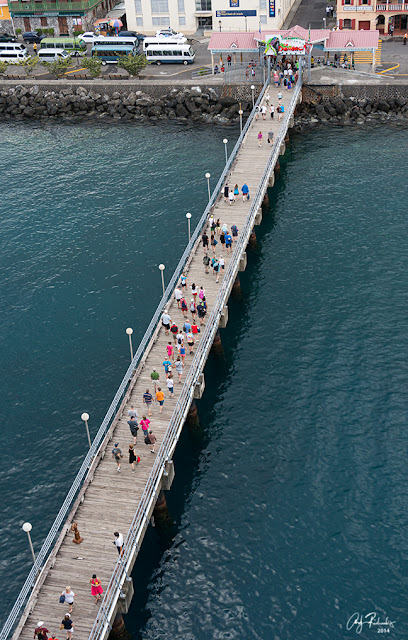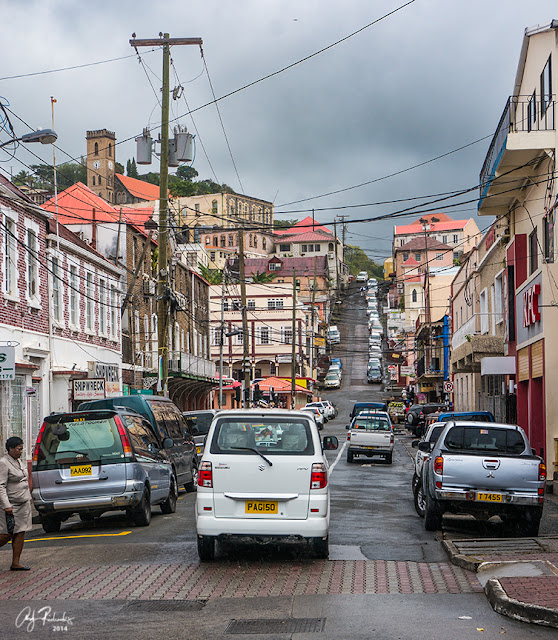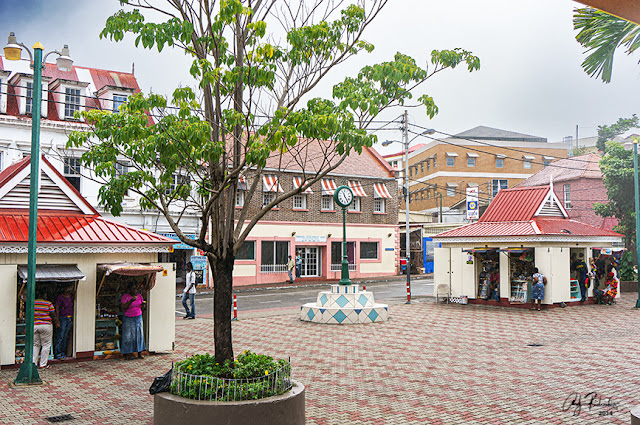a cruise in the Caribbean has its own relaxing, almost "Conch time" atmosphere
THIS TIME, we cruised with a group of friends from our then hometown of Saginaw, Michigan. There were 5 couples on this cruise, all of whom were connected primarily with one of my law partners and me. We have traveled with this group - or parts of it - a few times. Always fun. Disappointingly, searching my archives, I didn't find any images of all 10 of us at the same time.
ONE DIFFERENCE this time was that we did not cruise out of Florida, where we have on every other occasion when headed into the Caribbean. This cruise originated in San Juan, Puerto Rico. Having stopped in San Juan on prior year's Celebrity Reflection cruise, we were excited to see it again. The old part of the city, appropriately, "Old San Juan," has a real "old world" feel, with old buildings and Spanish-influenced architecture, two old Forts guarding the Old San Juan Harbor, and the generally colorful Caribbean culture. In the port there are some great bars and restaurants and just off the beaten path, some perhaps even better local establishments.
WE WERE in for a surprise, however. When making cruise stops in San Juan, the ships port in the Old San Juan harbor. You are immediately in the town as you walk off the ship. But for originating and terminating cruises, there is another, more remote cruise terminal, which is where we boarded our ship. It turns out that it was only a mile or so from the old city, but at the time, we didn't really know that. We arrived at San Juan airport around noon on the day we were scheduled to depart. Sail away was early evening (maybe around 6 p.m. - that was a long time ago and the memory banks are not as efficient as they once were 😐). What we could see around us looked like we were very remote, and with only a few hours, the logistics of a taxi or other transportation for 10 seemed like it was not worth it. Nor did the (second) Senor Frogs (looking like the only place to go at the terminal) seem that inviting. If we were just going to mingle and drink with other passengers, why not just do that on the ship, where we had already paid for our drinks? So, instead, we stayed on board and began to take immediate advantage of our drink packages. At least it was warm and sunny - a welcome relief from the winter temperatures we had just left that morning. In retrospect perhaps we should have gone into Old San Juan, as it was "touted" as one of our ports of call. One of my "gripes" about Celebrity, as a matter of policy, is when they do that, and port in a remote location with either no, or not very hospitable means of transportation into the main attraction. There may be a blog on that topic in the future. For us, this was the first experience with that.
I SOMETIMES wonder, these days, why we even go to the Caribbean, given that we live in an almost "Caribbean climate" now in the Tampa, Florida area. But we do love to cruise, and a cruise in the Caribbean has its own relaxing, almost "Conch time" atmosphere. I guess I answered my own question. 😁 Our experience has been that the weather is nearly always pleasantly sunny, the Caribbean clear and generally relatively calm, and the surroundings beautiful. We love to sit on the back of the ship and watch the sun set. And, sometimes, weather conditions conspire to demonstrate mother nature's majesty, like this rare, double rainbow of the Coast of Grenada in the Caribbean, during this cruise.
ANOTHER DIFFERENCE in this cruise was that we went to some places we had not been to before. We have done at least 6 Caribbean cruises over the years - and are certain to do more (including a planned, February 2023 cruise). For the most part, it seems like a lot of our stops are "been there, done that" repetitive. Most of our Caribbean cruises have been to the so-called, eastern Caribbean, and have so often included St. Thomas, St. Marteen, St. Kitts, and San Juan as to call them "regular" stops. This, though it did include St. Thomas, was to mostly new places, like St. Croix (U.S. Virgin Islands), St. Lucia, Dominica, and Grenada.
FROM SAN Juan, our first stop was St. Croix, USVI. We left the port on a Saturday afternoon, so our day on shore here was a Sunday. As is true of most of these island ports, tourism is a major industry. The history of St. Croix is similar to most of the other islands in the Antilles Archipelago. Beginning centuries before, with the migration of "indigenous" tribes of the Caribbean, it was "discovered" by Columbus in 1493. The island was populated and controlled at times by the Dutch, Spanish, British, and finally, Denmark for a period of time. During this mixed history there were long periods when the island was uninhabited.
IN 1916, Denmark sold Saint Croix, St. Thomas, and St. John to the United States. These islands now form the U.S. Virgin Islands (USVI), an incorporated U.S. territory, whose capital is in Charlotte Amalie, St. Thomas. The island's inhabitants were granted United States citizenship in 1927.
THE ISLAND houses one of the largest oil refineries in the world (formerly built and operated by the Hess Corporation in the 1960s). St. Croix is also the home of the Cruzan Rum distillery (interestingly, the distillery imports most of its sugar cane for rum production from Dominican Republic and South America). There is also a second distillery which produces Captain Morgan Rum. I didn't know about the rum distilleries when we visited. On a later Caribbean Cruise in 2015, I sought out some good rums - but mostly while we were in San Juan. Because we were in St. Croix on a Sunday, I doubt we could have arranged a tour/tasting for either facility. But it is something to think about for the future.
SO MANY of these very small Caribbean Islands (a number of them, nations; others, territories of larger nations), away from the commercial cruise ports, are generally quite poor and depressed. At one time almost wholly dependent upon tropical agricultural products (bananas and other fruits, coffee, cocoa, sugar, spices, etc.), they are now highly dependent on the tourism economy. And even then, I think a lot of the retail establishments in the port area are owned by or affiliated with larger - worldwide corporations, leaving much of the income generated by the islands to taxes and employment of its citizens. You can see this in the photos I made in Grenada. The second image is what you see immediately outside of the port area.
THE FOLLOWING day, our port was St. Kitts. My wife and I had been there in 2013 and had taken the narrow gage railroad up into the sugar plantations, and catamaran sail around the island. This time, our group was more ambitious. Well, some of them. There were five couples. The three "most athletic" of the guys (they all ran regularly and were reasonably fit for 3 "old guys" 😐) decided they were going to climb a volcano. The activity level was described as something like "moderately strenuous. Later, when they returned, all 3 admitted it nearly killed them. And they looked like they had been through a battle. The ladies all decided to take a jeep safari, and from what I can tell, they had a blast. The other two guys (you know, the ones who knew their limitations) exercised a little common sense, and just went ashore and wandered around. We may have provided the most important part of the day though. We found the spot where the beer was only $1!
ST. KITTS (short for St. Christopher) may be one of the most colorful of the Caribbean Islands. This was certainly true in and around the cruise port. But we even saw colorfully painted houses well back into the island during our Sugar Plantation excursion the year before. There was also a certain "local color" that often presented itself at as a photo-op.
OUR NEXT stop was another island we had never been to: Dominica (pronounced "domineeka," with the accent on the 3rd syllable). A part of the Windward Islands in The Lesser Antilles, this tiny island is its own commonwealth. Again, originally populated by indigenous Caribbean tribes, the island was colonized by France, sometime in the late 1490s. At that time, coffee was the primary commodity produced on the island and the French imported African slaves to work the coffee plantations. Following the Seven Years War between Britain and France, Britain took possession of Dominica and maintained it as British territory until 1978, when it was granted its independence and became a sovereign nation in its own right.
DOMINICA's CAPITAL city is Roseau. The Roseau cruise ship berth (there is only room for one ship to tie up, so we were the only ship there) is surprisingly unprotected. I was impressed by how high above the island our upper cruise ship deck placed us. My photo of the dock leading from the ship to the island has always been one of my favorite cruise photos, with its graphic sweep onto the island.
WHILE DOMINICA is known for its share of natural wonders, and has active volcanic activity, we didn't do much in the way of onshore tours or activities. Maybe some recovering from the prior day's activity? But the pattern here was a frequent feature of this cruise. We were all from Saginaw, Michigan which in February is deep into the throes of winter. We are usually weary of cold, dark, snowy and sometimes grimy conditions, with short days, long nights, and very little sunshine. A Caribbean vacation to us was about sun and relaxing. So, we weren't very ambitious for the most part. In most cases, we generally got of the ship for a couple hours, walked around, maybe did some souvenir shopping, and found a local bar to sample the local beverages (primarily the Caribbean beer offerings for the majority of us. Then we decided that since we had already paid for the "drink package" on board, we might as well go back to the ship.
GRENADA, OUR next stop on the following day is, perhaps at least for us Americans, best known for the 1983 U.S. invasion during the Reagan presidency. We docked at the cruise port terminal in the capital city: St. George's.























No comments:
Post a Comment
I WOULD LOVE TO READ YOUR COMMENTS: